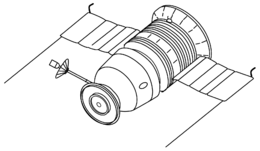Zond 6
Zond 6, a formal member of the Soviet Zond program and unmanned version of Soyuz 7K-L1 manned Moon-flyby spacecraft, was launched on a lunar flyby mission from a parent satellite (68-101B) in Earth parking orbit. The spacecraft, which carried scientific probes including cosmic ray and micrometeoroid detectors, photography equipment, and a biological payload (flies, bacteria and turtles), was a precursor to a manned circumlunar flight which the Soviets hoped could occur in December 1968, beating the American Apollo 8. However, after rounding the Moon, Zond 6 crashed on its return to Earth due to a parachute failure.
 | |||||||||
| Names | Soyuz 7K-L1 s/n 12 | ||||||||
|---|---|---|---|---|---|---|---|---|---|
| Mission type | Planetary Science | ||||||||
| Operator | Lavochkin | ||||||||
| COSPAR ID | 1968-101A | ||||||||
| SATCAT no. | 03535 | ||||||||
| Mission duration | 7 days | ||||||||
| Spacecraft properties | |||||||||
| Manufacturer | NPO Energia Company | ||||||||
| Launch mass | 5,375 kg (11,850 lb) | ||||||||
| Start of mission | |||||||||
| Launch date | 19:11:31, 10 November 1968 (UTC) | ||||||||
| Rocket | Proton-K/11S824 | ||||||||
| Launch site | Baikonur 81/26 | ||||||||
| End of mission | |||||||||
| Disposal | Crash landed | ||||||||
| Landing date | 17 November 1968 14:10 UT[1] | ||||||||
| Landing site | 70 km NE of Tyuratam, Kazakhstan, USSR[2] | ||||||||
| Orbital parameters | |||||||||
| Perigee altitude | 120 km (75 mi) | ||||||||
| Apogee altitude | 400,000 km (250,000 mi) | ||||||||
| Inclination | 51.5° | ||||||||
| Period | 500 days | ||||||||
| Flyby of Moon | |||||||||
| Closest approach | 14 November 1968 | ||||||||
| Distance | 2,420 km (1,500 mi) | ||||||||
| |||||||||
Mission
Zond 6 was the official designation for Soyuz 7K-L1 s/n 12. It was supposed to photograph the Moon in colour and in black and white from 8000 km and 2600 km ranges, then return to Earth, landing at Tyuratam only 16 km from the launch pad. It had been a long and difficult road to develop the L1 guidance system, but it worked perfectly that time.
Zond 6 flew around the Moon on 14 November 1968, at a minimum distance of 2420 km. Photographs of the lunar near side and far side were obtained with panchromatic film. Each photo was 5 by 7 in (130 by 180 mm). Some of the views allowed for stereo pictures. The photos were taken from distances of approximately 11,000 km and 3300 km. However, only one negative was recovered from the camera container.
Zond 6 used a relatively uncommon technique called "skip reentry" to shed velocity upon returning to Earth. A few hours before reentry, on 17 November 1968, a faulty O-ring rubber gasket caused the cabin to depressurise, killing all the animal test subjects aboard. Zond 6's parachutes also deployed too early and it crashed in Kazakhstan, near the designated landing area.
For propaganda reasons the Soviets claimed the flight was a success. A State Commission investigating the crash later determined that the coronal discharge effect which caused the parachute to jettison would only occur at the 25 mm capsule pressure. If the capsule had been completely depressurised to a high vacuum, the accident would not have occurred.
Details
- Launch Date/Time: 1968-11-10 at 19:11:31 UTC
- On-orbit dry mass: 5375 kg
See also
References
- Siddiqui, Asif A. "Beyond Earth: A Chronicle of Deep Space Exploration". NASA Science. Retrieved 8 January 2020.
- "Zond-6: Racing Apollo-8". www.russianspaceweb.com. Retrieved 29 July 2019.
External links
This article was originally based on material from NASA (NSSDC) information on Zond 6
